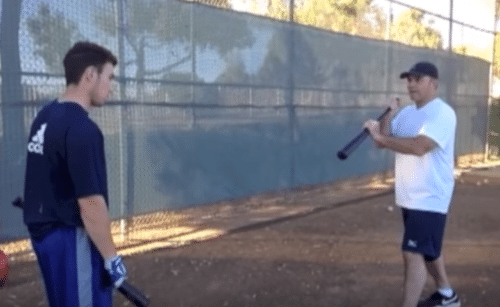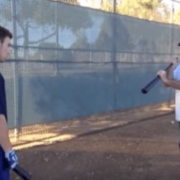Discover simple timing and rhythm hitting tips from Matt Nokes to quickly improve and fix a too early or late swing for baseball and softball batters. Get the front foot down on time and in games.
Timing Drills For Hitting A Softball Video: Quickly & Easily Get Hitters On-Time w/ “Snap Drill”
I don’t give much of my time to others’ timing drills for hitting a softball. And it’s not because I think I’m God’s green gift to baseball and softball. Actually, since January of 2013, I took a needed break learning hitting mechanics from others in the field, no matter how popular. I wanted to shed the hitting “BEER GOGGLES” that have stubbornly held this industry back for decades.
People ask me if I know anything about Tewks, Epstein, “Teacher Man”, etc. I don’t. And that’s the honest truth. I see their posts on Twitter and Facebook, but don’t give them anymore thought. The main reason? I’m still learning my own system!!

Matt Nokes talking about “leaning in and compressing the ball”. Photo courtesy: Matt Nokes’s YouTube channel
Besides, everyone has a different approach, view, and style. As you probably know, the timing drills for hitting a softball language can get quite confusing.
Back in 2013, I decided to stick to resources on Bio-mechanics, Physics, Psychology, etc. Because THIS is where the answers are. It’s not opinion, or someone’s theory or philosophy based on playing or coaching experience.
My #1 rule is to digest information that is validated by science. Don’t seek the footsteps of others, but seek the resources the “others” sought. In other words, don’t just take my timing drills for hitting a softball word for it.
That being said, there are a couple hitting coaches I do listen to, and one is Matt Nokes. I think he has an unmatched passionate curiosity for hitting, authentically wants to help hitters, is open to new ideas (can’t say that for many online gurus), and gets dramatic results with his hitters in a reasonably short amount of time.
As always, I’ve taken video notes for you, so you can skip around to what interests you most. Some of the things you’ll learn in the video are:
- Swing intention: what Matt Nokes means when he tells his hitters to “lean on it and compress it” (this will upset the ‘bug squisher’ coaches out there),
- Why hitters MUST swing in the same direction as their “swing motor” (and it’s not what you think),
- The “Snap Drill” that will easily and quickly get your hitters on-time (an Ah-ha moment for me!), and
- Much more…
Enjoy!
SCIENCE-BASED TRAINING:
Improve your hitting strategy dramatically by applying human movement principles.
Learn not only how and what to train but also the science behind the methods.
- About 1:00 minute mark, Matt didn’t think about Bat Speed when he was playing, he was trying to “lean on it and compress it”. He calls this “directional force”, in which he says it takes 8,000 pounds per square inch in one direction, to hit a ball 400-feet. CLICK HERE to see our Directional Force drill video.
- About 2:15 minute mark, Matt talks about how hips, knees and feet are the base, core is the motor, and arms are swing levers. What happens when swinging off the plane of the core motor. Swing in same direction as swing motor.
- About 3:30 minute mark, Matt distinguishes between keeping the barrel above hands as a cue versus what really happens. Don’t miss this. He uses this oftentimes blanket-used-coaching-cue to get the hitter flattening his/her barrel to the pitch plane. Barrel MUST match shoulder plane.
- About 5:30 minute mark, Matt defines a timing drills for hitting a softball approach as summing up what you’re trying to do mechanically into a one or two word cue. Ever changing because getting new info, new feelings, new observations. Talks about 2-3 minute “priming” movements before heading into battle.
- About 10:15 minute mark, great hitters don’t “keep their hands inside the ball” in a way that creates what Matt calls slack. He refers to the Fence Swing Drill that exaggerate swinging down.
- About 12:00 minute mark, Matt talks about transferring force with a bent landing knee, comparing to a Pole Vaulter’s pole when it sticks into the ground before propelling the athlete up. Landing bent allows for adjustment. “The front knee isn’t straightened, it gets straightened. The back leg doesn’t turn, it gets turned. The core moves the legs.”
- About 14:45 minute mark, Matt breaks down how to “flatten” the swing. Tells hitter minimal movement from lower half swings, just focus on moving shoulders, hands, and bat. Matt gives limited parameters, and let’s hitter learn the lesson…in other words, he doesn’t map out step by step how to move the way he wants the hitter to move. Gives hitter an outcome and allows them to fill in the blanks.
- About 16:30 minute mark, Matt talks about swing approach like what you’d do to chop down a tree. You wouldn’t think about how did I swing the ax yesterday. You’d just start swinging it! Finishing low with the hands and following the line of impact. I call this driving the big nail (Matt’s bat in the video) flush into the wall. At about 20:00 minute mark, Matt adds to this and tells hitter to “lean on this” and “compress it” (referring to his bat). He says that he just gave hitter permission to hit the crap out of the ball.
- About 18:30 minute mark, compares big picture timing drills for hitting a softball cues to Fence Swing Drills. The latter being ineffective as a default way to hit. You have to hit with big picture in mind of what you want to do to the ball. Swing intention.
- About 21:00 minute mark, Matt begins to talk about timing. Timing is a distance, and to make it simple by synchronizing timing from release to contact. Matt talked about how he took a guy hitting the ball 360-380 feet to hitting it 480-feet in 2.5 months…over the fence, 400-feet off a tee. “Feel” contact…stay sideways and feel contact by leaning and compressing the ball. Matt talks about the “Snap Drill”. This is golden! He also talks about the “Ride” part of “Ride & Stride” that Matt promotes within his system.
If you remember one timing drills for hitting a softball thing from this video, it’s from the 21st minute on… 🙂 Golden.
Unlike most MLB players and coaches, Matt Nokes has an intuitive sense of the swing. He can explain it from a “real” point of view, and transition that into “feel”. His system seems to fill in the blanks that I’ve always had about the swing. The good news about his principles is they’re very simple and easy to implement. Matt has a very common sense approach to hitting.
- CLICK HERE to visit his Hitting Solutions website to get more information,
- Subscribe to him on YouTube, and
- Follow him on Twitter…
Thanks Matt!






